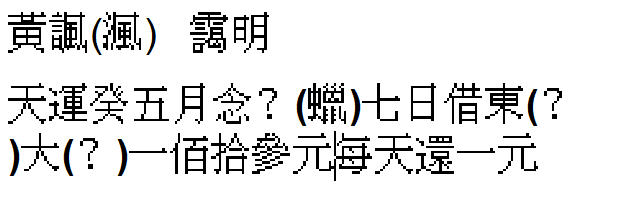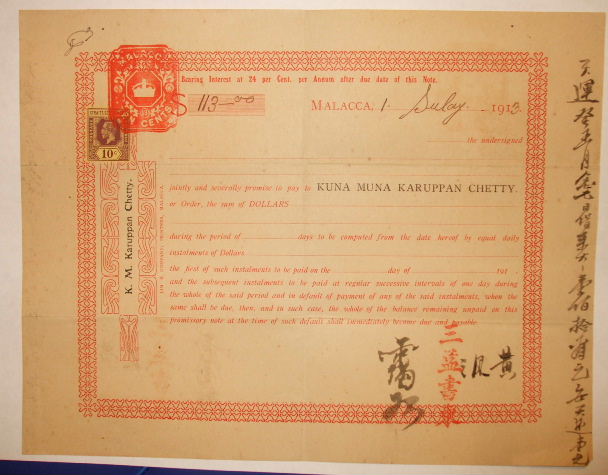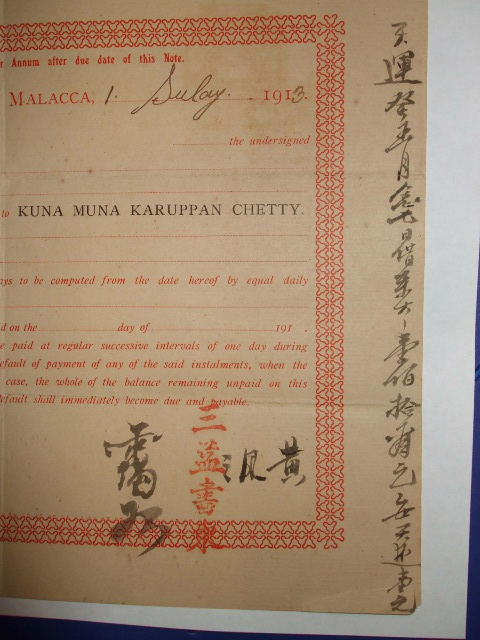
|
Subject:A Malacca note of 1913
Posted By: Bill Fri, Apr 09, 2010
I am not surprised in not seeing anybody attempting to translate these Chinese characters written on your Malacca note because like I had said before in this forum very often it is very difficult to decipher a person's Chinese cursive handwriting. Just like English cursive,especially those that were written by physicians are extremely difficult to decipher.
The problem with trying to understand these Chinese characters written on this note is not only that they are hard to read but it requires an understanding of a really OLD Chinese dating system, Chinese financial numbering system and may be even both Malay and Indian dating system, language or customs.
This note appears to be some sorts of loan agreement that was made between an Indian company or moneylender, Kuna Muna Karuppan Chetty (at first I thought it was Malay), with the two people who undersigned in Chinese at the bottom of the note in 1913. This note was printed in English and had a canceled King George V's 10 cent duty stamp pasted on it. I believe it was because in 1913, Malacca was part of British India and was therefore under British rule. I happen to collect coins of British Commonwealth including those of Straits Settlement.
There appear to be the words "1 Sulay" written in front of 1913 which first appear to be the day and month to me first but Sulay is not Malay at all. I wonder if it can be the name of a Sultan? Sulay seems to be an Indian name. May be other members who can read Malay or Indian can shed some light.
The interest rate of this loan agreement was quite outrageous, it states at the top (in English) of the note that it would charge an annual interest rate of 24% after the due date of the note. The funny thing is that there does not appear to be any due date being stated on the note.
There are a few Chinese characters written on the note that I am not 100% sure what they are and therefore my translation may not be 100% accurate. I put a question mark (?) right
next to the characters I am unsure of.
Those Chinese characters that were written at the right-hand side of the note, from top to bottom,
to the best of my knowledge are: (I put them here from left to right):
天運癸五月念﹖(蠟)七(?)日借東(﹖)大(﹖)一佰拾參元
每天還一元
The first two words, 天運 Tian Yun, comes from the 4-word idiom - 奉天承運 Feng Tian Cheng Yun which was used in the opening of Holy Decrees of an emperor in ancient China:
奉天承運,皇帝詔曰:
In ancient China, the dating of any events or documents was always by the years of the current reigning emperor (monarchy) in China, such as Emperor QianLong Year 3. Unfortunately, after the end of the Qing dynasty and with the establishment of Republic of China in 1911, there was no longer any reigning monarch. However, many Chinese who were still used to this OLD Chinese dating system chose to use 天運 Tian Yun in the place of the emperor for dating purpose.
The third character is 癸 Gui, which in this case it will be 癸丑 Gui Chou or the Year of Gui Chou.
Therefore, the first 3 words, 天運癸 Tian Yan Gui means 1913, same as that was written in English.
The next two words, 五月 Wu Yue means fifth month or May.
The next three words, 念﹖(蠟)七(?)are hard to read and I can only give my best guess:
I know for sure the last character of the three is日 ri means day. However, the two characters in front of it are hard to figure out. I guess the first one is 念 Nian, in this case it was written as a short form for 蠟 la, the one after it is Qi七 means 7. Therefore the three words together, I believe means the 7th day.
The next 3 words, 借東(﹖)大(﹖)
借 Jie means either borrow from or loan to.
The next two words are hard to figure out. I guess they may be 東大 Dong Da only because the four-word vertical chop mark at the note's right bottom corner also has the word 東 Dong as the last character of the seal. Therefore Dong Da could be the name of some type of business or it can be anything.
一佰拾參元 Yi Bai Shi Shen Yuan means One hundred ten three dollars, which means one hundred thirteen dollars or # 113, same as written in Arabic numerals on the note. Please note that because regular Chinese numerals are too simple and are therefore very easy to be altered(for forgery) especially if they are used on financial instruments, therefore special Chinese financial numbers, Daxie, were used for financial purpose (http://en.wikipedia.org/wiki/Chinese_numerals)in China.
There is actually another Chinese numbering system used for bookkeeping purpose and I used to know them when I helped out in my cousin's school uniform shop in Hong Kong but I had since forgotten most of them.
The last five words:
每天還一元 Mei Tian Huan Yi Yuan means Every day returning (paying back) one dollar
Therefore, my guess for ALL the Chinese characters written on the note will be:
On 7th May 1913 loaned to Tung Da $ 113, paying back $1 per day.
Of course, loaned to can also mean borrowed from, but I believe in this case it is more likely loaned to.
The strange part is that it does not specify the due date (or beginning payback date) of this loan of $113 or the last date of pay back because if the lender is charging an annual interest rate of 24% then the borrowers have to pay back more than the $ 113 they borrowed and therefore the paying back period has to be longer than 113 days.
It is possible that the borrowers might have signed a note stating that they were borrowing $ 113 but they would actually receive only $100 but had to return the whole amount of $113 at the rate of $1 per day until the whole amount was paid off. Therefore, the $13 the lender took off on the front end would serve as interest. Of course, this is only my guess.
At the right bottom corner of the note, in the middle there was a four-word chop mark (in red) that says:
三孟書東 San Meng Shu Dong
It seems to be the name of some business but it did not make a lot of sense. May be somebody who knos more about Malacca can shed some light.
There are two Chinese names signed on either side of the chop mark, the one on its left (top to bottom) is:
靄明 Ai Ming
and the right (right to left) is:
黃諷 Huang Feng or 黃渢 Huang Feng2 (Cannot tell for sure what the last word may be).
Well, I guess this would be the best I can do.
Enjoy.
Bill



|
 translate chinese writing
translate chinese writing  ( China & Japan ) - John - Apr 03, 2010 (06:39 PM)
( China & Japan ) - John - Apr 03, 2010 (06:39 PM)  A Malacca note of 1913
A Malacca note of 1913  - Bill - Apr 09, 2010 (07:03 PM)
- Bill - Apr 09, 2010 (07:03 PM)  The correct ways to write the Numeral 3 in Chinese DaXie - Bill - Apr 11, 2010 (07:11 PM)
The correct ways to write the Numeral 3 in Chinese DaXie - Bill - Apr 11, 2010 (07:11 PM)  Re: A Malacca note of 1913 - john - Apr 11, 2010 (09:55 PM)
Re: A Malacca note of 1913 - john - Apr 11, 2010 (09:55 PM) 

